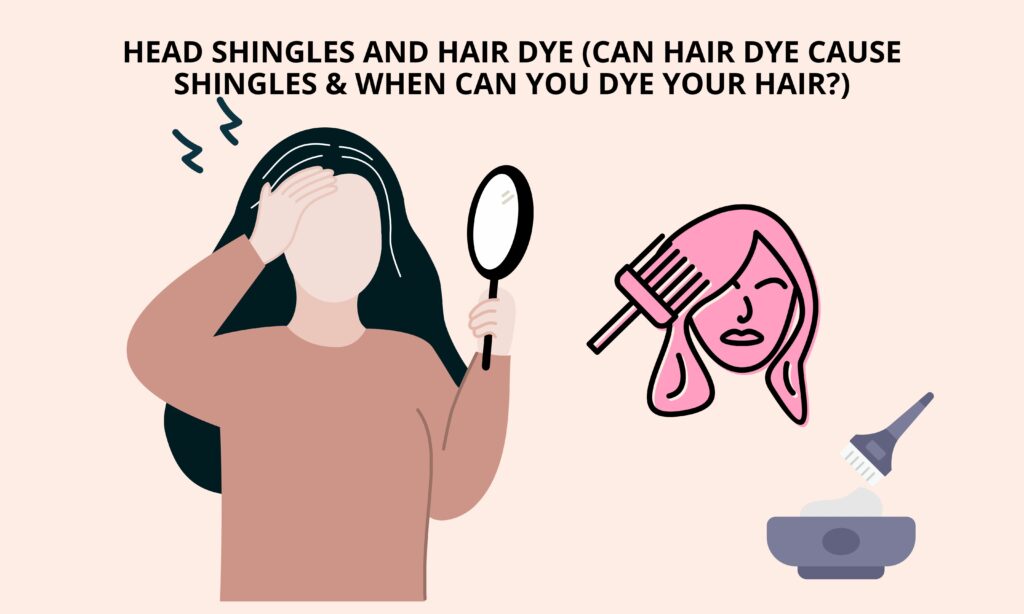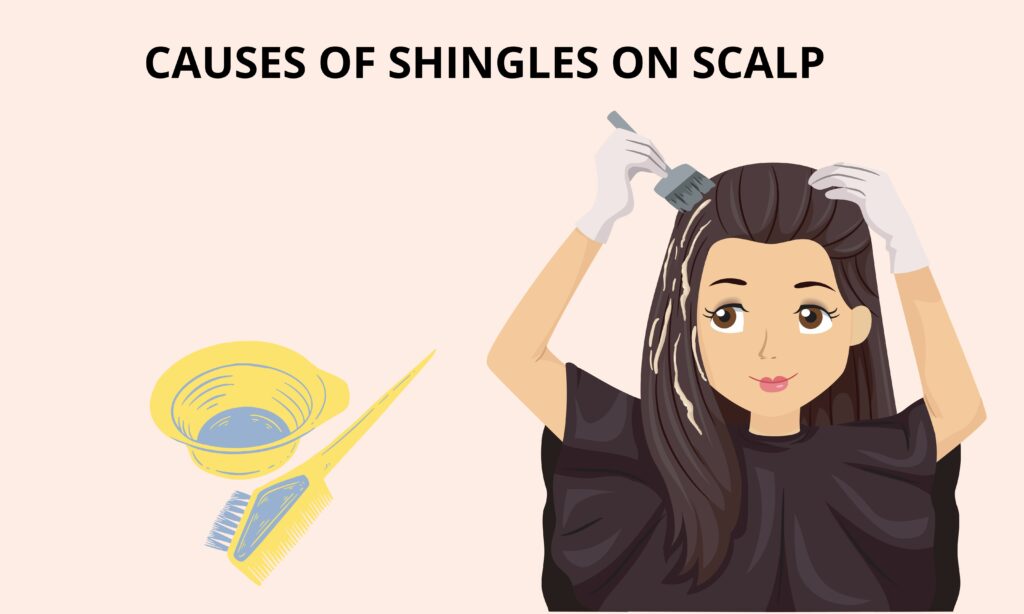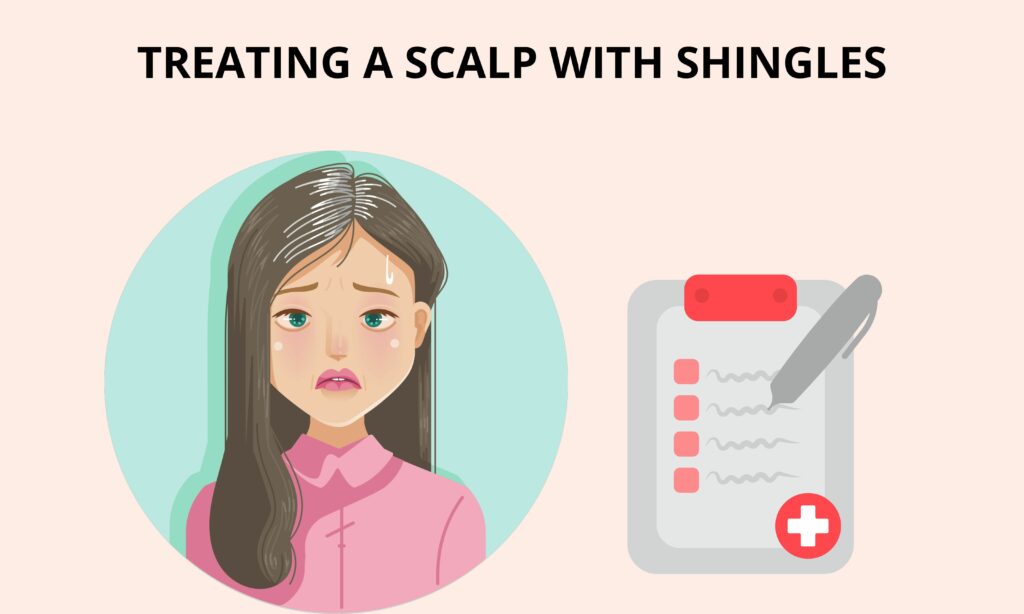
Head shingles is a viral infection that can cause painful blisters on the scalp and face. It is caused by the varicella-zoster virus, which also causes chickenpox. While there is no direct link between head shingles and hair dye, some research suggests that hair dye may weaken the immune system, making it easier for the virus to take hold.
When it comes to hair dye and head shingles, there is no clear consensus among medical professionals. Some experts believe that hair dye can increase the risk of developing shingles, while others argue that there is no significant correlation between the two. While the evidence is inconclusive, it is still important to take precautions when dyeing your hair.
If you have a history of shingles or are experiencing symptoms such as itching or burning on your scalp, it is recommended that you avoid hair dye until you have fully recovered. Additionally, if you are currently undergoing treatment for shingles, you should avoid using hair dye until you have completed the full course of medication.
When considering whether or not to dye your hair, it is also important to take into account the ingredients in the dye itself. Some hair dyes contain harsh chemicals that can irritate the scalp and weaken the immune system. If you are prone to shingles outbreaks, it may be best to opt for a natural or organic hair dye that is free of harmful chemicals.
Ultimately, the decision to dye your hair while dealing with head shingles is a personal one. While there is no definitive answer as to whether or not hair dye can cause shingles, it is important to take precautions and be mindful of your own health and well-being. If you have any concerns or questions, it is always best to consult with your healthcare provider before making any changes to your hair care routine.
Harsh symptoms of shingles on scalp
Head shingles, also known as herpes zoster, is a painful viral infection that affects the nerves and skin on the scalp and face. The condition is caused by the same virus that causes chickenpox, and it can be extremely uncomfortable and debilitating. While head shingles is not directly caused by hair dye, certain chemicals found in hair dye may exacerbate the symptoms of the condition.
One of the most common symptoms of head shingles is a painful rash that develops on the scalp and face. The rash is typically characterized by red, fluid-filled blisters that can be extremely tender and itchy. In some cases, the rash may also cause swelling and inflammation, making it difficult to move the affected area.
In addition to the rash, head shingles can cause a range of other unpleasant symptoms, including fever, chills, headache, and fatigue. Many people also experience a tingling or burning sensation in the affected area, as well as muscle weakness and joint pain. These symptoms can be especially harsh when the rash is located on the scalp, as it can make it difficult to sleep, eat, and perform other daily activities.
Treating head shingles on the scalp can be challenging, as the area is often covered by hair and can be difficult to access. Treatment typically involves a combination of antiviral medications, pain relievers, and topical creams to help soothe the rash and reduce inflammation. In some cases, doctors may also recommend a prescription-strength shampoo to help reduce itching and prevent infection.
If you are experiencing symptoms of head shingles, it is important to seek medical attention as soon as possible. While the condition can be uncomfortable and painful, prompt treatment can help reduce the severity of symptoms and prevent complications. Additionally, if you have a history of head shingles, it may be best to avoid hair dye or other harsh chemicals that can irritate the scalp and trigger an outbreak.
Causes of shingles on scalp

Head shingles, also known as herpes zoster, is a viral infection caused by the varicella-zoster virus (VZV), which also causes chickenpox. The virus can remain dormant in the nervous system for years, and when it reactivates, it can cause painful rashes on the skin. While shingles can occur anywhere on the body, it can also affect the scalp, causing discomfort and embarrassment.
- Immune system – There are several factors that can contribute to the development of shingles on the scalp. One of the most common causes is a weakened immune system. When the body’s defense mechanism is compromised, it becomes more vulnerable to viral infections, such as shingles. Factors that can weaken the immune system include stress, aging, and certain medical conditions.
- Exposure to hair dye – Another potential cause of shingles on the scalp is exposure to hair dye. Some people may experience an allergic reaction to the chemicals in hair dye, which can cause inflammation of the scalp and increase the risk of developing shingles. It is important to note that not all cases of head shingles are caused by hair dye, but it can be a contributing factor in some cases.
Additionally, individuals who have had chickenpox in the past are at risk of developing shingles. The virus remains dormant in the body after a person has chickenpox, and it can reactivate at any time, causing shingles. While shingles is more commonly seen in older adults, it can affect people of any age.
- HIV/AIDS – Other risk factors for shingles on the scalp include a history of skin cancer, HIV/AIDS, or other medical conditions that weaken the immune system. Individuals who are taking immunosuppressive medications or undergoing chemotherapy may also be at higher risk of developing shingles.
In conclusion, shingles on the scalp can be a painful and uncomfortable condition that is caused by the reactivation of the varicella-zoster virus. While there are many potential causes of shingles on the head, including a weakened immune system and exposure to hair dye, not all cases can be attributed to these factors. If you are experiencing symptoms of shingles on your scalp, it is important to seek medical attention to receive proper diagnosis and treatment.
Shingles on scalp
Head shingles, also known as herpes zoster, can cause painful rashes and blisters on the scalp. The condition is caused by the varicella-zoster virus, which also causes chickenpox. While shingles can affect any part of the body, it can be particularly uncomfortable when it affects the scalp, as it can cause itching, burning, and sensitivity. There are several risk factors associated with head shingles, including exposure to hair dye.
Hair dye contains a variety of chemicals that can irritate the scalp and cause an allergic reaction. Some of these chemicals can penetrate the skin and cause inflammation, which can increase the risk of developing head shingles. It is important to note that not everyone who uses hair dye will develop shingles, and there are many other factors that can contribute to the development of the condition.
In addition to hair dye, other risk factors for head shingles include a weakened immune system, advanced age, and a history of chickenpox. The varicella-zoster virus can remain dormant in the body for years, and it can reactivate when the immune system is weakened or compromised. This can happen as a result of stress, illness, or other factors.
Symptoms of head shingles can include pain, itching, and burning on the scalp, as well as the appearance of a rash or blisters. The condition can be diagnosed through a physical examination and a review of medical history. Treatment options may include antiviral medications, pain relievers, and topical creams to reduce itching and inflammation.
Prevention of head shingles can be achieved through several methods, including vaccination, maintaining a healthy immune system, and avoiding exposure to potential triggers such as hair dye. It is also important to practice good hygiene, including washing the scalp regularly with a mild shampoo and avoiding scratching or picking at any rashes or blisters that may appear.
In conclusion, head shingles can be a painful and uncomfortable condition that can be caused by a variety of factors, including exposure to hair dye. While not everyone who uses hair dye will develop shingles, it is important to be aware of the potential risk factors and take steps to prevent the condition from occurring. If you experience symptoms of head shingles, seek medical attention to receive an accurate diagnosis and appropriate treatment.
Shingle and hair dye
Shingles, also known as herpes zoster, is a viral infection caused by the varicella-zoster virus (VZV), the same virus that causes chickenpox. The condition is characterized by a painful rash that can appear anywhere on the body, including the scalp. While there are many potential causes of shingles on the head, exposure to hair dye is a potential trigger that can increase the risk of developing the condition.
Hair dye contains a variety of chemicals that can irritate the scalp and cause an allergic reaction. This can lead to inflammation and increased susceptibility to head shingles. Not everyone who uses hair dye will develop shingles, but it is important to be aware of the potential risk factors associated with this cosmetic product.
In addition to hair dye, other risk factors for head shingles include a weakened immune system, advanced age, and a history of chickenpox. The varicella-zoster virus can remain dormant in the body for years, and it can reactivate when the immune system is weakened or compromised. This can happen as a result of stress, illness, or other factors.
Symptoms of head shingles can include pain, itching, and burning on the scalp, as well as the appearance of a rash or blisters. The condition can be diagnosed through a physical examination and a review of medical history. Treatment options may include antiviral medications, pain relievers, and topical creams to reduce itching and inflammation.
Prevention of head shingles can be achieved through several methods, including vaccination, maintaining a healthy immune system, and avoiding exposure to potential triggers such as hair dye. It is also important to practice good hygiene, including washing the scalp regularly with a mild shampoo and avoiding scratching or picking at any rashes or blisters that may appear.
In conclusion, head shingles can be a painful and uncomfortable condition that can be triggered by exposure to hair dye. While not everyone who uses hair dye will develop shingles, it is important to be aware of the potential risk factors and take steps to prevent the condition from occurring. If you experience symptoms of head shingles, seek medical attention to receive an accurate diagnosis and appropriate treatment.
Treating a scalp with shingles

Head shingles, or herpes zoster, can be a painful and uncomfortable condition that affects the scalp. While there are several potential causes of shingles on the head, including exposure to hair dye, the focus of treatment is on managing symptoms and promoting healing. Here are some tips for treating a scalp with shingles:
- Take antiviral medications: Antiviral medications can help to reduce the severity and duration of head shingles. These medications work by inhibiting the replication of the virus that causes shingles. They are most effective when taken within 72 hours of the onset of symptoms, so it is important to seek medical attention as soon as possible.
- Manage pain: Head shingles can be very painful, and over-the-counter pain relievers may not be enough to provide relief. Your doctor may prescribe stronger pain medications, such as opioids, to help manage pain. Alternatively, they may recommend non-medical pain management techniques, such as cold compresses or relaxation techniques.
- Keep the scalp clean: It is important to keep the scalp clean and free of debris to promote healing and prevent infection. Use a mild shampoo to wash the scalp, and avoid harsh chemicals or hair products that may irritate the skin.
- Avoid scratching: It can be tempting to scratch at the rash or blisters that develop with head shingles, but this can make the condition worse. Scratching can spread the virus to other parts of the body, and it can also increase the risk of developing a secondary infection. Try to resist the urge to scratch, and seek medical attention if you are having trouble managing the itch.
- Rest and relaxation: Head shingles can be a stressful and tiring condition, and it is important to take time to rest and relax. Stress can weaken the immune system and make symptoms worse, so try to engage in activities that promote relaxation and stress relief, such as meditation, yoga, or deep breathing exercises.
In conclusion, treating a scalp with shingles involves managing symptoms, promoting healing, and preventing the spread of the virus. Antiviral medications, pain management techniques, and good hygiene practices can all be helpful in managing head shingles. If you have concerns about your symptoms or are having trouble managing the condition, seek medical attention to receive an accurate diagnosis and appropriate treatment.
FAQs
Here are some frequently asked questions about head shingles and hair dye:
- Can hair dye cause head shingles? While exposure to hair dye is not a direct cause of head shingles, it can increase the risk of developing the condition. Hair dye contains chemicals that can irritate the scalp and cause an allergic reaction, which can lead to inflammation and increased susceptibility to shingles.
- How can I prevent head shingles? Preventing head shingles involves maintaining a healthy immune system, practicing good hygiene, and avoiding exposure to potential triggers such as hair dye. Vaccination is also an effective way to prevent shingles.
- What are the symptoms of head shingles? Symptoms of head shingles can include pain, itching, and burning on the scalp, as well as the appearance of a rash or blisters. Other symptoms may include fever, fatigue, and headache.
- How is head shingles diagnosed? Head shingles can be diagnosed through a physical examination and a review of medical history. Your doctor may also order blood tests or a culture of the rash to confirm the diagnosis.
- What is the treatment for head shingles? Treatment for head shingles may include antiviral medications, pain relievers, and topical creams to reduce itching and inflammation. Your doctor may also recommend non-medical pain management techniques, such as cold compresses or relaxation techniques.
- Can I still use hair dye if I have had head shingles? If you have had head shingles, it is important to wait until the rash has cleared up before using hair dye again. You should also avoid using hair products that may irritate the scalp or trigger an allergic reaction.
- Can head shingles be contagious? Head shingles can be contagious to individuals who have not had chickenpox or have not been vaccinated against the virus. It is important to avoid close contact with others until the rash has healed and to practice good hygiene to prevent the spread of the virus.
In conclusion, head shingles and hair dye are two common topics that are often associated with each other. While hair dye can increase the risk of developing head shingles, there are several ways to prevent and manage the condition. If you have concerns about your symptoms or are having trouble managing the condition, seek medical attention to receive an accurate diagnosis and appropriate treatment.
To summarize
In summary, head shingles and hair dye are two topics that are often associated with each other. While hair dye is not a direct cause of head shingles, it can increase the risk of developing the condition. Exposure to hair dye can cause an allergic reaction, which can lead to inflammation and increased susceptibility to shingles.
Symptoms of head shingles can include pain, itching, and burning on the scalp, as well as the appearance of a rash or blisters. Other symptoms may include fever, fatigue, and headache. Treatment for head shingles may include antiviral medications, pain relievers, and topical creams to reduce itching and inflammation.
Preventing head shingles involves maintaining a healthy immune system, practicing good hygiene, and avoiding exposure to potential triggers such as hair dye. Vaccination is also an effective way to prevent shingles. If you have had head shingles, it is important to wait until the rash has cleared up before using hair dye again. You should also avoid using hair products that may irritate the scalp or trigger an allergic reaction.
It is important to keep the scalp clean and free of debris to promote healing and prevent infection. Use a mild shampoo to wash the scalp, and avoid harsh chemicals or hair products that may irritate the skin. Avoid scratching the rash or blisters that develop with head shingles, as this can spread the virus to other parts of the body and increase the risk of developing a secondary infection.
In conclusion, head shingles and hair dye are two common topics that are often associated with each other. While hair dye can increase the risk of developing head shingles, there are several ways to prevent and manage the condition. If you have concerns about your symptoms or are having trouble managing the condition, seek medical attention to receive an accurate diagnosis and appropriate treatment.